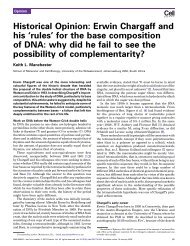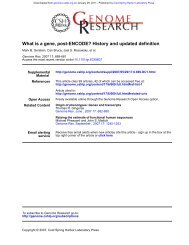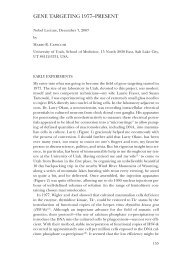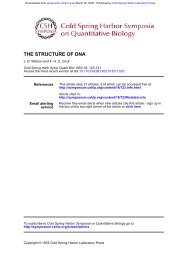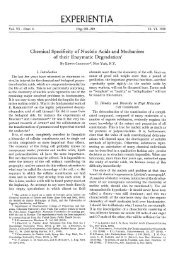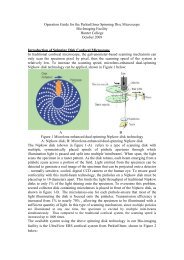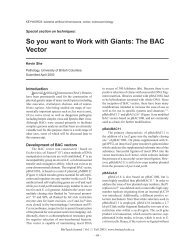134D.R. Forsdyke, J.R. Mortimer / Gene 261 (2000) 127±137At the molecular level, we see similar forces acting at thelevel of meiosis. Here paternal and maternal chromosomalhomologs align. Forsdyke has proposed that if there is suf®cientsequence identity, so that the DNA `dialects'[(C 1 G)%] match, meiosis is likely to progress throughvarious check-points (Page and Orr-Weaver, 1996), andgametes will be formed. If there is insuf®cient identity (i.e.the DNA `dialects' do not match) meiosis will fail, gameteswill not form, and the individual will be sterile, ± a `mule'.Thus, the original parental lines will be reproductivelyisolated from each other, and as such would be de®ned asdistinct species. Changes in the (C 1 G)% dialects have thepotential to initiate speciation (Forsdyke, 1996b).9. The unpairing postulateMuller (1922) suggested that the pairing of genes as partsof chromosomes undergoing meiotic synapses, mightprovide clues to gene structure and replication:ªIt is evident that the very same forces which causethe genes to grow should also cause like genes toattract each other, ¼If the two phenomena are thusdependent on a common principle in the make-up ofthe gene, progress made in the study of one of themshould help in the solution of the other.ºIn 1954 he set his students an essay `How does theWatson-Crick model account for synapsis?' (Carlson,1981). Crick (1971) took up the challenge with his `unpairingpostulate' by which the two strands of the classical DNAduplex would unpair to allow a homology search.Recent work on the meiotic alignment of chromosomessuggests that initiation of speciation involves that aspect ofthe genome phenotype (reprotype), which is constituted bythe genome-wide potential to extrude stem-loops. Those ofthe maternal and paternal chromosomal homologs maymutually explore each other and test for `self' DNA complementarity,using the `kissing' mechanism of Tomizawa(Eguchi et al., 1991; Hawley and Arbel, 1993; Kleckner,1997). If suf®cient complementarity is found (i.e. thegenomes are reprotypically compatible), then crossingover and recombination can occur. The main adaptivevalue of this would be to provide for the correction of errorsin the individual homologs (Winge, 1917; Bernstein andBernstein, 1991).Where does the (C 1 G)% `dialect' come into this? It hasbeen observed that small ¯uctuations in (C 1 G)% wouldhave a major effect on the ability of duplex DNA moleculesto extrude stem-loops and on the pattern of loops which thenoccur. A very small difference in (C 1 G)% (reprotypicdifference) would mark a meiotically pairing DNA as`not-self'. This would impair the kissing interaction with`self' DNA (Forsdyke, 1998; Bull et al., 1998), and sowould disrupt meiosis and allow divergence between thetwo parental lines, thus initiating speciation (Forsdyke,1996b). Consistent with this, direct tests of incipient speciationin the fruit ¯y (the phenomenon known as Haldane'srule) implicate differences in DNA per se, rather than indistinct genes, as initiating reproductive isolation (Naveiraand Maside, 1998; Forsdyke, 2000a). Similar considerationsmay apply to the phenomenon of `heteroduplex resistance'between recombining DNAs of different bacterial species(Majewski and Cohan, 1998).Once a speciation process has begun, prezygotic factorsand postzygotic factors other than (C 1 G)% are likely toreplace the original difference in (C 1 G)% as a barrier toreproduction (i.e. a barrier to recombination). In thiscircumstance, (C 1 G)% becomes free to adopt otherroles, such as the prevention of intragenomic recombination.This could involve intragenomic differentiation ofregions of high and low (C 1 G)% (isochores). Thesehave the potential to `reproductively isolate' (i.e. recombinationallyisolate) different parts of the genome. Thus, theattempted duplication of a globin gene into a-globin and b-globin genes might have failed since sequence similaritywould favour recombination between the two genes andany incipient differences would be eliminated. However,the duplication appears to have involved relocation to adifferent isochore with corresponding changes in(C 1 G)%, so that the two genes became recombinationallyisolated. As a consequence of the differences in (C 1 G)%the corresponding mRNAs utilize different codons for correspondingamino acids, even though both mRNAs are translatedin the same cell using the same ribosomes and tRNAFig. 3. Summary of potentially con¯icting evolutionary pressures as manifestat the level of mRNA (dark line with arrow-head). (1) (C 1 G)%pressure (`GC pressure') acting primarily at the genomic level, and secondarilyaffecting mRNA base composition. (2) Fold (stem-loop) pressureacting primarily at the genomic level and secondarily affecting mRNAbase order. (3) Purine pressure acting primarily at the cytoplasmic levelto enrich loops with purines. (4) Coding pressure deriving from classicalenvironmental interactions with the conventional phenotype, which resultin base changes in the protein-encoding part of the mRNA. (5) Regulatorypressures (small grey boxes) acting primarily at the cytoplasmic level,which result in base changes mainly in the 5 0 and 3 0 non-coding regions.
Table 1Postulated evolutionary processes leading to multiple levels of information in genomesD.R. Forsdyke, J.R. Mortimer / Gene 261 (2000) 127±137 135Environmental selectivefactorsSelection for mutationswhich:Primary effect on DNAfunctionBiological resultObserved featuresof modern DNAClassical phenotypicselective factorsCompetitors with moreef®cient translationMutagensRecombinationally `notself'sexual partnersChange encoded proteins None Change in classicalphenotypePurine-load RNAs None Ef®cient translationwith no `self' dsRNAformationPromote DNA stem-looppotentialImpair homology searchbetween DNAs ofspecies members whosesequences are divergingWithin species meioticrecombination promotedMeiotic recombination isimpairedChange in genomephenotype for DNArepairChange in genomephenotype forspeciationUsually change in abase pair inaccordance withChargaff's ®rstparity ruleChargaff's clusterrule and Szybalski'stranscriptiondirection ruleChargaff's secondparity ruleChargaff's GC rulepopulations. Thus, it is unlikely that the primary pressure todifferentiate codons arose at the translational level (Granthamet al., 1986). Isochores would have arisen as a random¯uctuation in base composition in a genomic region suchthat one product of a gene duplication was able to survivefor a suf®cient number of generations to allow functionaldifferentiation to occur. The regional base compositional¯uctuation would then have `hitch-hiked' through thegenerations on the successful duplicate.The multiple evolutionary pressures acting on mRNAsand genomes are summarized in Fig. 3 and Table 1. Itshould be noted that changes in genetic ®tness (changes inthe number of progeny transmitted to future generations),could result from changes in the classical phenotype and/orin the genome phenotype. A mutation which appearedneutral with respect to protein function might neverthelessaffect ®tness by changing the genome phenotype. It isargued elsewhere that the apparently neutral polymorphismof some intracellular proteins is an adaptation to facilitateintracellular self/not-self discrimination (Forsdyke, 2000b).10. Universal Darwinism?Chargaff was well aware of the evolutionary implicationsof his work, writing of `the survival of the ®ttest nucleicacids' (Chargaff, 1951). However, <strong>Biology</strong> satis®ed withwhat was called `the modern synthesis' (Carlson, 1981),had not kept pace with Chemistry, and it was dif®cult forhim to explore the implications of his discovery (Chargaff,1979). Romanes and Bateson, who had challenged Darwiniandogma, had been dismissed by generations of biologistsbewitched by genes and all that they promised. To put itmildly, the level of discourse was not constructive.Systematist Ernst Mayr (1980) when expressing `somethoughts on the history of the evolutionary synthesis' classi®edBateson as among those geneticists who failed tounderstand evolution (implying that others understood itbetter). The plant geneticist Ledyard Stebbins (1980)commenting on `botany and the synthetic theory of evolution'blamed Bateson for `delaying the synthesis'. The`universal Darwinist' Richard Dawkins lamenting the positionhe perceived to have been taken by the `mutationists ofthe early part of this century' noted Dawkins (1983) that:ªFor historians there remains the baf¯ing enigma ofhow such distinguished biologists as ¼W. Bateson ¼could rest satis®ed with such a crassly inadequatetheory. ¼The irony with which we must now readW. Bateson's dismissal of Darwin is almost painful.ºDespite the overwhelming rhetoric to the contrary, we arenow beginning to appreciate the deep truths which Romanesand Bateson were attempting to convey (Forsdyke, 1999a,b,2000a). When Bateson died in 1926, Chargaff was twenty.He is still with us, ± a citizen of the twenty ®rst century. Wewish him well.AcknowledgementsWe thank Richard Grantham and Tim Greenland for a veryhelpful review of the manuscript, and Jim Gerlach for assistancewith computer con®guration. Academic Press, ColdSpring Harbor Laboratory Press, Elsevier Science and theNational Research Council of Canada gave permission toplace full-text versions of some of the above cited papers inForsdyke's web pages, which may be accessed at:http://post.queensu.ca/,forsdyke/homepage.htm.ReferencesBall, L.A., 1972. Implications of secondary structure in messenger RNA. J.Theor. Biol. 36, 313±320.



